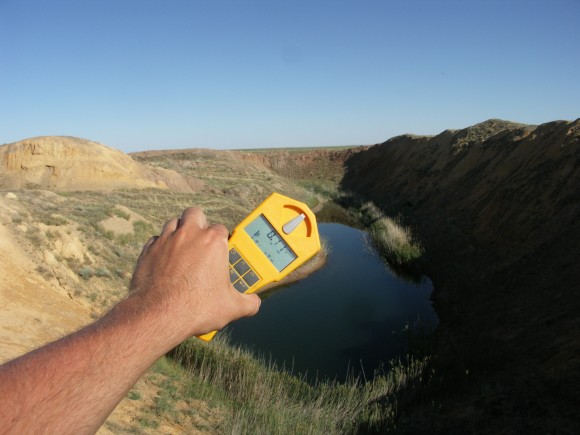A few months ago, I blogged about Operation Groundhog — an effort to secure nuclear material left by the Soviet Union at the former Semipalatinsk Nuclear Test Site.
Efforts in Kazakhstan, like the sealing of 178 nuclear test tunnels, were initially public. (The tunnel sealing was said to be complete in 2000.) I noticed that the program, around 2005, simultaneously went black and experienced a sharp increase in fuding. “What happened?” I asked.
Now, Ellen Barry in the New York Times explains: Scavengers started popping open the tunnels.
Here is the key passage from Barry:
Meanwhile, the vast test site was unsecured and scavengers were combing the tunnels for copper wire that could be sold to Chinese dealers. About 10 people are known to have died from crawling into a tunnel and breathing contaminated air, said Yuri G. Strilchuk, director of training and information at the National Nuclear Center.
Early on, the problem seemed manageable. In 1999, Senator Richard Lugar, Republican of Indiana, announced that an American-financed effort was sealing up the last of the tunnels. But local scavengers used bulldozers and explosives to re-open them, in some cases dislodging the 50-meter plugs of reinforced concrete, Mr. Kadyrzhanov said. By 2004, 110 of the 181 sealed tunnels had been reopened, according to the National Nuclear Center.
“The mentality of a Soviet person has changed,” Mr. Kadyrzhanov said. “Fifty years ago, if they saw barbed wire or a concrete wall they would go away. But now, it’s the opposite — they will climb the fence just to see what is inside.”
The effort that began afterward was more urgent, more costly and more secretive, perhaps in part because after Sept. 11, 2001, there was anxiety that radioactive materials would be used to construct dirty bombs. Vladimir V. Putin, then Russia’s president, met with President Nursultan A. Nazarbayev of Kazakhstan in 2004 to discuss the transfer of more archived documents from Russia.
Some scavengers.
(I am still interested in all the photos on Panoramio by user Tetrix Tetrix, including the one atop this post, who took his Geiger Counter on a very interesting tour of Eastern Kazakhstan.)
Honorable mention goes to Cordula Meyer at Der Spiegel, who had all the details of the story in January including the scavengers but didn’t quite put it together. (Meyer thought there might be more tunnels, which seemed plausible to me at the time.)
So, now we understand why the US government was so eager to keep the lid on the program. There is no sense in advertising the location and vulnerability of all the material until the program is completed. And, suddenly, the UAVs and other security assistance makes a lot more sense.
One final note. Barry mentions the story of an orphaned nuclear device that was destroyed in 1995. “Activity ended so abruptly that a nuclear device lowered into one tunnel in preparation for a test sat unexploded until 1995,” she writes, “when technicians managed to destroy it without creating a nuclear reaction, according to the National Nuclear Center.”
That description is correct — right down to calling it a device — but let’s dwell on this since it is so interesting. Gaukhar Mukhatzhanova, one of our brighter stars at CNS, explains the device was “a 0.3-0.4 kiloton charge designed for testing the resistance of weapons and equipment to the destructive effects of an atomic explosion.” Unlike other nuclear weapons that Kazakhstan shipped back to Russia, “removing the device was considered too dangerous” and instead “the charge was destroyed in May 1995 inside the tunnel.” A Kazakh scientist gave a presentation on the device at a conference in 1997. Unfortunately, I don’t have the presentation, but a CNS staff member at the time summarized the remarks in a pretty useful trip report.


How much copper was in there!?
Anything else they may have been scavenging?
Seems like there may be easier places to scavenge copper.
My guess is that there is some plutonium in those tunnels – no device is 100% efficient. Interestingly, Russia shared information about old tests and the U.S. apparently has samples from the tunnels.
That was a point I made in explaining why Russia might not be interested in providing a lot of help to the US. I am told that I am exaggerating the Russian concern, however.
Jeffrey, Did they tell you that U.S. nuclear forensics is no good? Speaking seriously, I would agree – all this “sensitive information” stuff is highly overrated.
Don’t they understand the big red “run away from death” signs???
Damn, where’s that ‘Like’ button when you need it??
One of the great difficulties in advancing the plutonium disposition program, the “trilateral initiative” to place excess U.S. and Russian plutonium under IAEA safeguards, and the verification of warhead dismantlement has been Russia’s concern about revealing the precise isotopics of its plutonium. Does Russia’s willingness to provide details regarding some of the activities at Semey reflect a change in attitude on this issue — perhaps a recognition that the United States already has this data? If so, it might facilitate the above initiatives, e.g., simplifying the plutonium disposition effort by making it unnessary to include process steps that disguise plutonium attributes.